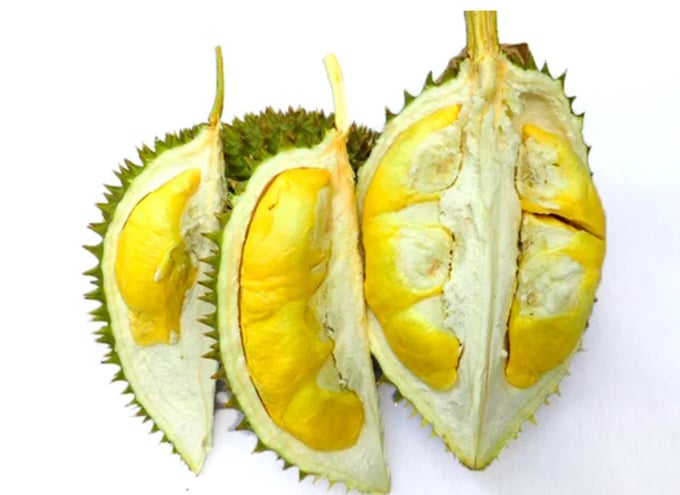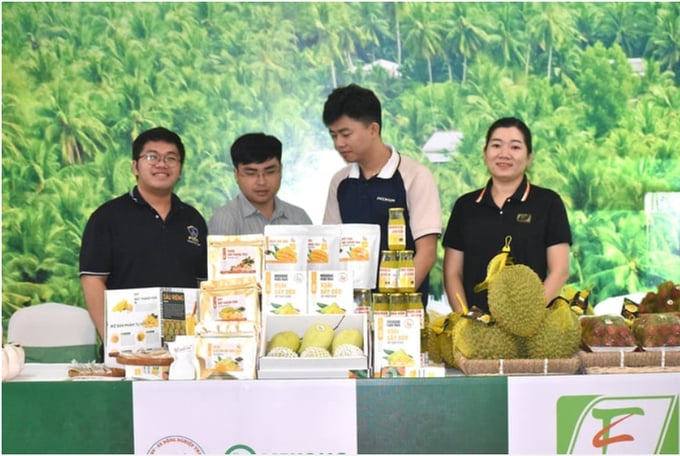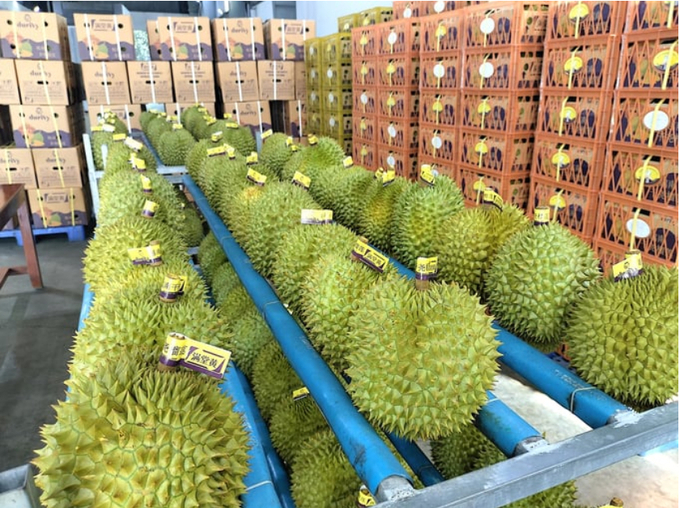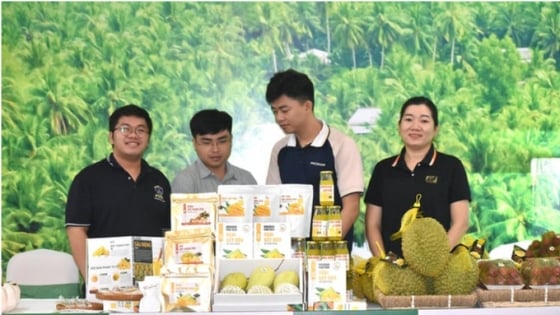(VAN) ‘Cai Mon Durian’ is not a specific variety of durian but rather a name used to refer to durian varieties originating from the Cai Mon area in Cho Lach District.
The first geographical indication for durian products in the country
Recently, Ben Tre province announced the geographical indication for seven products, including Cai Mon durian. This makes it the first locality in the country to have a geographical indication for durian. Before Cai Mon durian, no durian product had been protected by a geographical indication. Some products had been developed with collective trademarks and certification marks, such as Cai Lay durian (Tien Giang), Cam My durian (Dong Nai), Da Hoai durian (Lam Dong), Dak Mil durian (Dak Nong), Hoa Thuan durian (Kien Giang), Khanh Son durian (Khanh Hoa), and Ngu Hiep durian (Tien Giang).

The Ri6 durian grown in Ben Tre has an edible ratio of up to 32.85%. Photo: Minh Dam.
Cai Mon durian is not a single variety of durian but rather a name used to refer to durian varieties originating from the Cai Mon area in Cho Lach district. Initially, Cai Mon durian was mainly concentrated in Cho Lach district, renowned for its distinctively delicious quality. Later, the cultivation area for Cai Mon durian expanded to Chau Thanh district and some communes in Mo Cay Bac district bordering Cho Lach district, where the geographic location, soil conditions, climate, and freshwater sources for irrigation are similar.
Currently, the Ri6 and Monthong durian varieties play a dominant role, accounting for about 90%. According to research by the Ben Tre Department of Science and Technology, the analysis and comparison of the physical and chemical properties of Ri6 and Monthong durian varieties grown in Ben Tre province with those from Binh Duong and Dong Nai regions show clear differences, especially the higher edible flesh ratio, demonstrating the superior quality of “Cai Mon” durian.
Specifically, the Ri6 variety has elliptical-shaped fruit, with an average weight of 2.61 kg/fruit (ranging from 2 to 3.5 kg/fruit). The fruit’s skin is greenish-yellow when ripe, with tall, sparse, pentagon-shaped, and smooth thorns. The flesh is dark yellow, dry, not sticky, fiberless, and usually not mealy. The flesh is thick, with a high flesh ratio, having a rich, sweet, and fragrant taste. The seeds are small, with a low seed-to-fruit ratio, and the flesh ratio is 32.85%.

Cai Mon durian on the day Ben Tre announced its Geographical Indication. Photo: Minh Dam.
Regarding the Monthong variety, the fruit is cylindrical with a pointed apex and an average weight of 3.62 kg per fruit (ranging from 3 to 5 kg per fruit). Monthong durian usually has clearly defined segments, and its skin is yellow-brown when ripe. The flesh is very thick, light yellow, moderately fibrous, and prone to being mealy, especially when the flesh turns white, which commonly occurs during the rainy months (July-August). The flesh has a high ratio, is dry, sweet, and rich. The seeds are small, with a low seed-to-fruit ratio, and the flesh ratio is 33.09%.
Additionally, the quality indicators of the fruit, such as sweetness (Brix level), richness, and the content of essential minerals like potassium, calcium, magnesium, iron, and zinc, are mostly higher in Cai Mon durian compared to the same varieties grown in the other two regions.
According to the Ben Tre Department of Science and Technology, the natural conditions, soil, climate, hydrology, rivers, and cultivation practices in the province offer unique advantages for durian growth compared to other regions. Specifically, the land formed by the alluvial deposits of the Tien River system, rich in medium nutrients, contributes to the distinctive aroma, flavor, sweetness, color, and richness of durian, which has gained widespread fame.
Concerns Over the Brand Infringement of Ben Tre Durian
Ben Tre province currently has over 2,760 hectares of durian, with nearly 2,000 hectares of fruit-bearing orchards concentrated in the districts of Cho Lach, Chau Thanh, and Mo Cay Bac, yielding an average annual output of approximately 24,198 tons. In July 2022, the Protocol on Phytosanitary Requirements for the export of durian from Vietnam to China was signed, opening up significant opportunities for businesses and durian producers in Vietnam in general, and Ben Tre in particular.

The Ben Tre Provincial People\’s Committee recently sent Official Letter No. 4702 to the Ministry of Foreign Affairs requesting prompt support for the protection of the “Ben Tre Durian” certification trademark in China. Photo: Minh Dam.
Besides significant opportunities, the production and export of durian face many challenges and risks. One of these challenges is the issue of exported durian not meeting quality standards, which damages the product’s brand. To maintain and protect the reputation and quality of Ben Tre’s exported durian to the Chinese market, the Ben Tre Department of Science and Technology is processing the registration of the certification mark “Ben Tre Durian” in China.
The application for protection was submitted to the China National Intellectual Property Administration and was accepted on June 14, 2023. However, the review process for the trademark registration has been slow and prolonged, significantly affecting production and business plans for durian in particular and the local socio-economic development in general.
Therefore, the Ben Tre People’s Committee has recently issued Official Dispatch No. 4702 to the Ministry of Foreign Affairs, requesting assistance in quickly securing the certification mark “Ben Tre Durian” in China. The aim is for the province to establish intellectual property rights for the “Ben Tre Durian” certification mark and to prevent unauthorized use of the “Ben Tre” geographical name for durian.
The Ben Tre People’s Committee has requested the Ministry of Foreign Affairs, the Vietnam Trade Office in China (Ministry of Industry and Trade), and the Intellectual Property Office (Ministry of Science and Technology) to support the request for expedited examination, announcement, and granting of protection certificates for the “Ben Tre Durian” certification mark by the end of this year. This will allow the locality and the community of durian producers and traders to timely use this certification mark for harvesting and exporting durian (off-season) to the Chinese market.
Agriculture News | Agri Products Price



